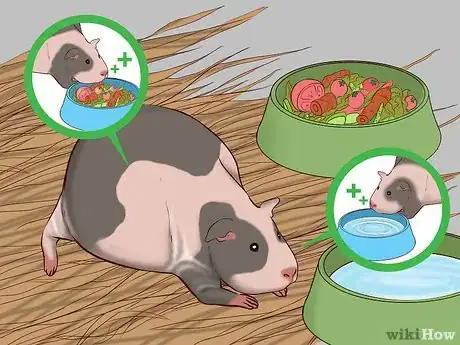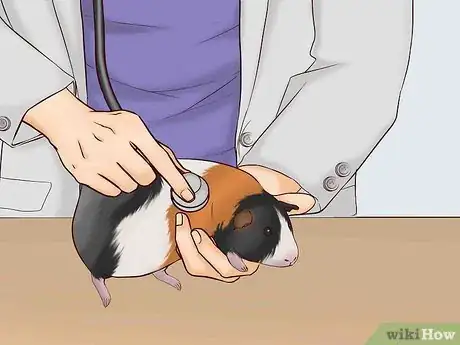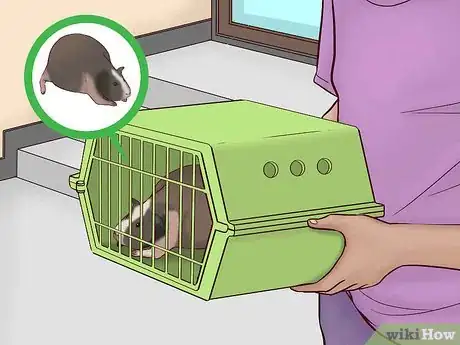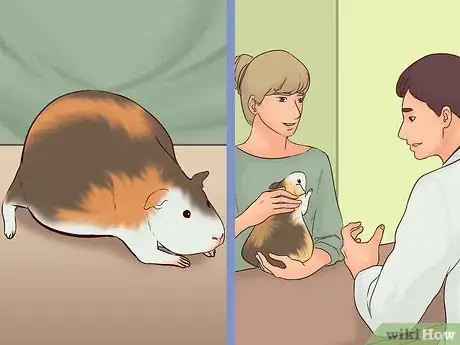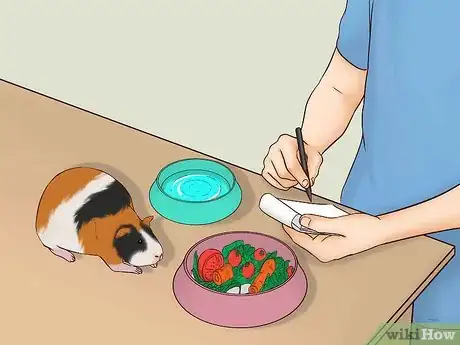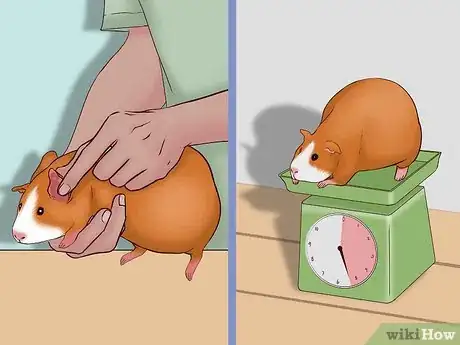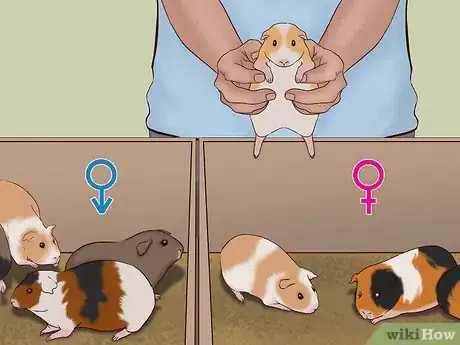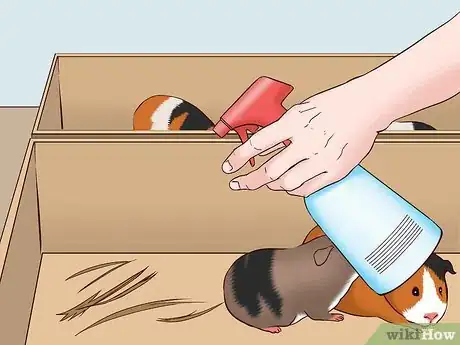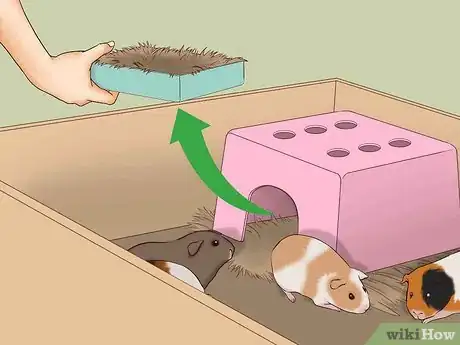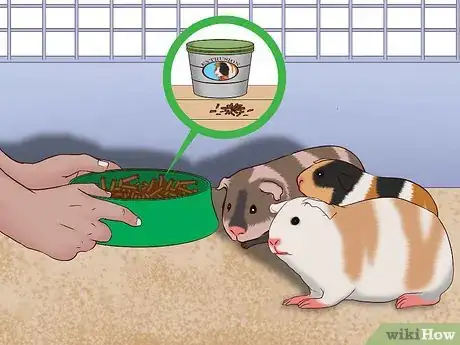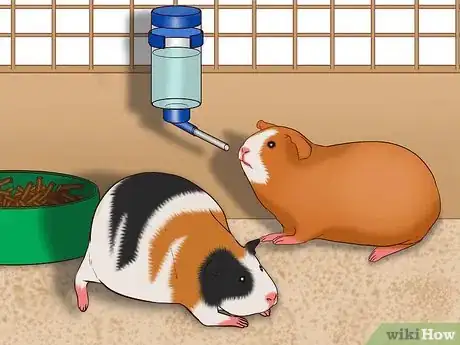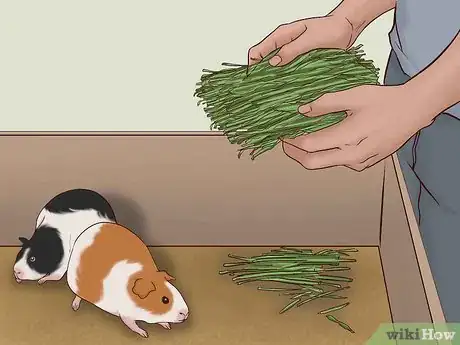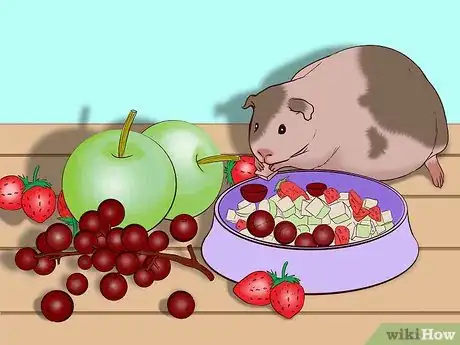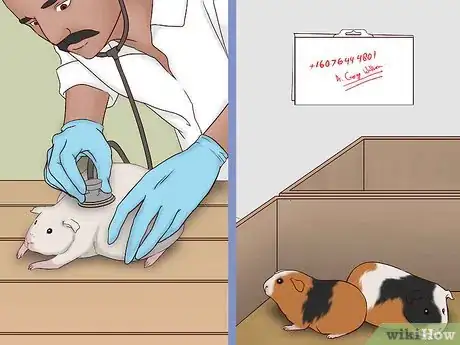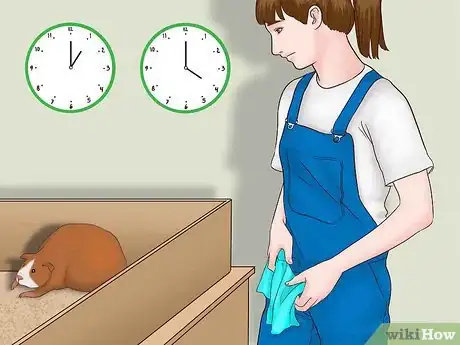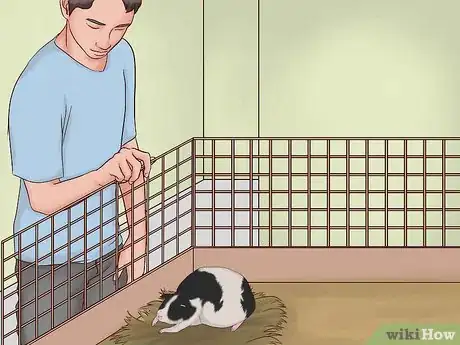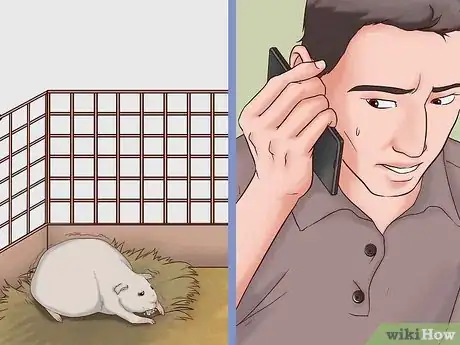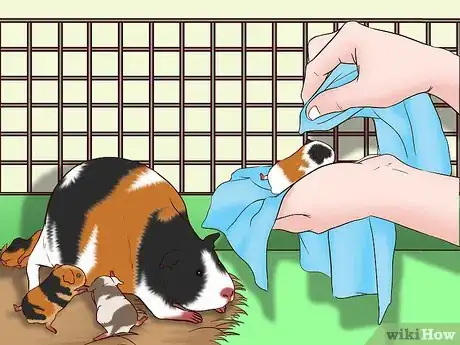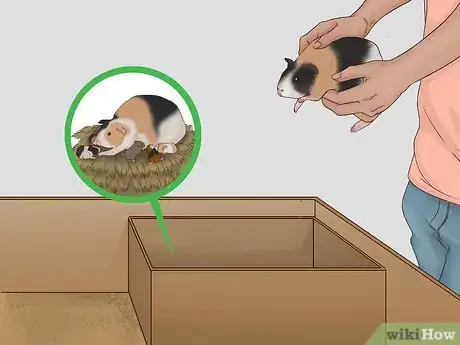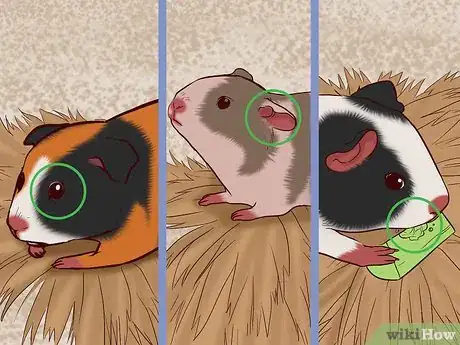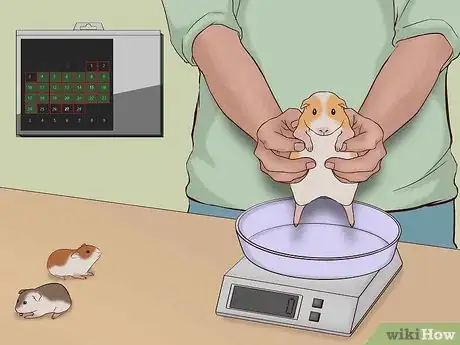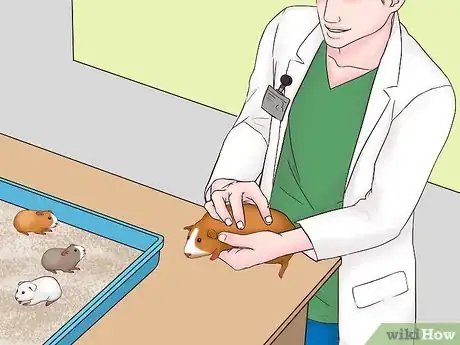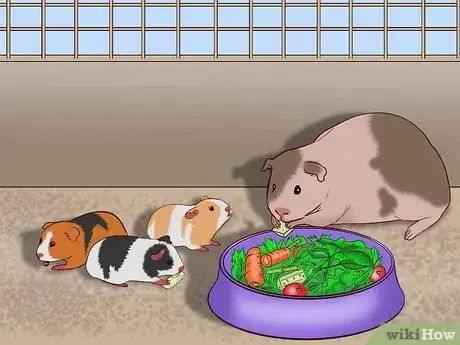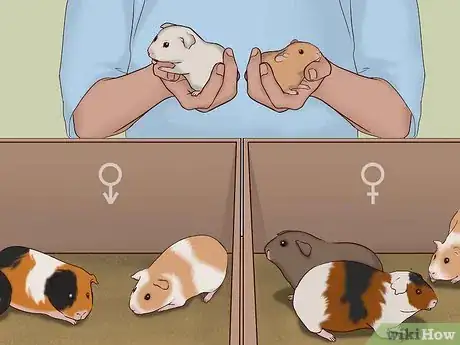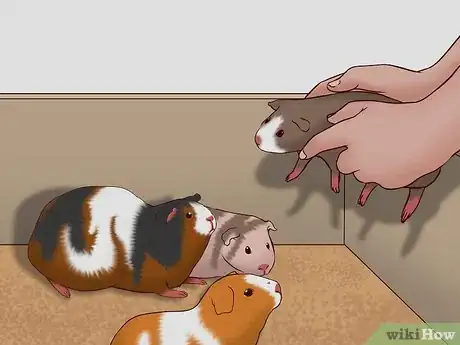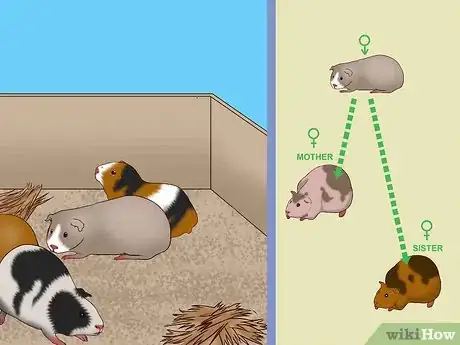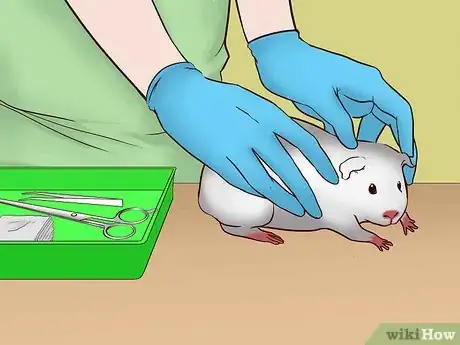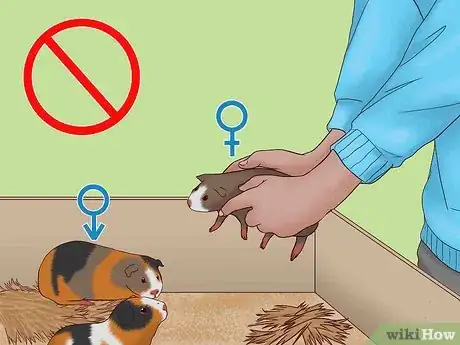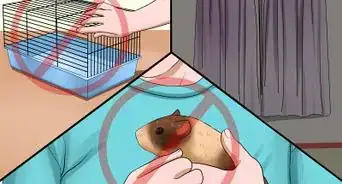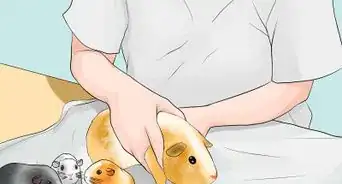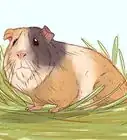This article was co-authored by Pippa Elliott, MRCVS. Dr. Elliott, BVMS, MRCVS is a veterinarian with over 30 years of experience in veterinary surgery and companion animal practice. She graduated from the University of Glasgow in 1987 with a degree in veterinary medicine and surgery. She has worked at the same animal clinic in her hometown for over 20 years.
wikiHow marks an article as reader-approved once it receives enough positive feedback. This article received 14 testimonials and 88% of readers who voted found it helpful, earning it our reader-approved status.
This article has been viewed 325,870 times.
Pregnancy is hard work for a female guinea pig. She may carry several pups, between one and six, and they're carried in the womb for 58 – 73 days.[1] . There is a high maternal mortality rate for guinea pigs (about 20%) as they are vulnerable to complications and illnesses such as toxemia. Whilst guinea pigs should never be bred intentionally, coming home from the pet store with a guinea pig who is already pregnant is a common story. However, with the proper care, this risk can be significantly reduced and your pregnant guinea pig can be kept in good health.
Steps
Discovering the Pregnancy
-
1Look for symptoms of pregnancy. Physical signs of pregnancy are hard to detect, and often only become apparent towards the end of pregnancy. Nevertheless, you may notice your guinea pig begin to eat and drink more, and their belly begin to grow — see Tell if Your Guinea Pig Is Pregnant. Do not apply pressure to the abdomen as you may cause a miscarriage.
- Be aware that young guinea pigs will begin to eat more as they grow anyway.
- Small litters do not cause the belly to enlarge significantly, and will not be as noticeable.
- All guinea pigs enjoy burrowing down in hay, but do not nest specifically because of pregnancy.
-
2Have the pregnancy diagnosed by a vet. If you suspect your sow is pregnant, take her to the vet to make sure. The vet will feel her abdomen to check for the presence of fetuses and may use an ultrasound. The vet should be able to give an estimated due date.
- Feeling the abdomen needs to be done by a professional because it is easy to mistake the bladder, kidney, or even an enlarged ovary for a foetus. Rough handling may cause miscarriage.
- The ultrasound, is a non-invasive procedure and can confirm the pregnancy. The ultrasound will also be able to confirm how many pups there are, and how many of them are alive.
Advertisement -
3If the pregnancy is unexpected, determine where the sow became pregnant from. Either the sow was already pregnant when you purchased her or one of the other guinea pigs she has had contact with was a boar.
- Pet shops are notoriously bad for sexing guinea pigs and may have mis-sexed one of your guinea pigs. Get an experienced vet to check the sex of all your other guinea pigs.
- Pet stores also often house both sexes together, and some breeders do not separate the sexes early enough so it is possible the sow was already pregnant when you bought her.
-
4Determine if the sow’s age makes it a high risk pregnancy. Sows should be over four months old, and under seven months old for their first pregnancy. If they have been pregnant before, they should be under two years old.
- If your pregnant guinea pig does not meet the age requirements, talk to your vet about a pregnancy plan. For young guinea pigs, this may include supplementing her diet with Critical Care of a similar product. For older guinea pigs, this may include her carrying out her pregnancy and birth housed at the vets, as she is more likely to need intervention.
- This is because sows who are too young are at a greater risk of vitamin deficiencies during pregnancy.
- Sows who are too old are at a greater risk of the pelvis not being 'elastic' enough to expand during the birthing process
- If your pregnant guinea pig does not meet the age requirements, talk to your vet about a pregnancy plan. For young guinea pigs, this may include supplementing her diet with Critical Care of a similar product. For older guinea pigs, this may include her carrying out her pregnancy and birth housed at the vets, as she is more likely to need intervention.
-
5Determine if the sow’s body condition makes it a high risk pregnancy. Sows who are overweight are at higher risk of toxemia. If your sow was overweight before she became pregnant, discuss with your vet what her diet should be during pregnancy as this is obviously a bad time to restrict her diet.
-
6Determine if the sow’s or boar’s breed makes the pups more vulnerable to hereditary disease. Dalmatian and Roan guinea pigs carry a lethal gene recessively. If one parent is of these breeds, for each pup there is a 25% chance it will be born lethal. There are other hereditary diseases that can affect guinea pigs, so where possible check the parentage of the pregnant sow and the boar who fathered the pups.
- If there is a likelihood any of the pups are born with this condition you must decide what action you will take. If you are not prepared to care for them yourself, a more experienced guinea pig owner may be willing to take them or you may make the decision to have them put down.
- Lethal guinea pigs are white in colour (not albino) are born blind, usually in both eyes, have crooked or deformed teeth, are often also deaf and often suffer from internal deformities particularly to the digestive organs. These pups may die within a few days of birth, or may live for several years. If they do survive the first week they have a shorter than normal life expectancy and will require large amounts of medical care throughout their lives.
Health during Pregnancy
-
1Pregnant guinea pigs are particularly vulnerable to illness as a result of stress during pregnancy. It can be a trigger for diseases such as toxemia, or can scare the sow so she doesn’t want to eat or drink. For these reasons stress should be minimized as much as possible.
- Reduce exposure to loud noises or bright lights.
- Keep her away from direct sunlight.
- Establish a daily routine with set times and stick to it, to provide consistency
- Make any changes as early as possible in the pregnancy, when the stress will have less of an effect on the sow.
- Reduce handling to minimal levels.
- During the last two weeks of pregnancy, do not handle the sow. Instead, coax her onto a towel or into a box.
-
2Monitor her eating and drinking habits. It's very important to check on your guinea pig several times a day, ideally every three to four hours. Each time you check, make a mental note of how much water she has drunk and how much food she has eaten.
- This allows you to gauge what is normal, so that if she becomes unwell and stops eating, or becomes very thirsty, you will pick up clues early on.
- If the sow becomes uninterested in food contact your veterinarian immediately. The vet will assess the guinea pig’s condition. They may prescribe treatment that includes injections of dextrose solutions, steroids and calcium, which may or may not be effective. Loss of appetite can also be a symptom of pregnancy toxemia.
-
3Give the sow a thorough check over twice a week. Check her for signs of illness (e.g. crusty eyes/nose/ears or a thinning/patchy coat) and weigh her. In the last two to three weeks of pregnancy, do not handle the sow. Instead, coax her onto a towel or into a box.
- The sow should gradually put on weight. How much depends on the size of the litter, but her weight should never begin fall.
- If you have any concerns, do not hesitate to get to a vet.
-
4Limit grooming during pregnancy. Grooming usually requires a lot of handling, so reduce to minimal levels during pregnancy. If the sow is long haired, cut all of her hair short (especially around her rear end) towards the end of the pregnancy as the sow will find it harder to clean herself and the hair may become knotted or dirty.
- Do not bath the sow during pregnancy. It will be too stressful for her.
-
5Continue to exercise the sow. Continue to allow her ‘floor time’ or to graze outside. Reduce handling by coaxing her into a box or onto a towel to move her. It is important to keep her active to prevent obesity and keep a healthy blood flow, but do not chase her or force her to exercise as pregnancy, particularly large litters, puts pressure on the circulation in guinea pigs and they are prone to heart attacks.
Housing during Pregnancy
-
1Ensure you are providing adequate housing. See Properly Care for Your Guinea Pigs for what kind of housing is suitable. Ensure the temperature is consistent and do not use multi-level housing.
- The temperature outside or in a garage/shed usually becomes too cold at night for a pregnant guinea pig. Pregnant guinea pigs should be kept inside.
- Do not keep pregnant guinea pigs in multi-level cages/hutches as their balance will be impaired by pregnancy, and in the later stages of pregnancy they may not be able to get up to the higher tiers.
-
2Remove any boars. If you have multiple sows, remove the boar immediately to prevent others from becoming pregnant as well. If this is the only sow you own, the boar must be removed before the sow reaches 50 days in her pregnancy.
- The boar must be removed by 50 days as he may continue to mount her which can be stressful or painful in later pregnancy, and she could become pregnant again as early as two hours after the birth.
-
3Remove other sows if you need to. The pregnant sow can be kept with other companions of the same sex if she gets on with them. Guinea pigs are social animals and should be kept in groups even whilst pregnant.
- If there are any signs that the pregnant sow is not getting on with another guinea pig, do not hesitate to remove the other guinea pig, but leave the pregnant sow in the hutch/cage she is in.
- Remove any other pregnant sows. The placenta contains hormones which can trigger contractions. If the other sow eats it, their own pregnancy may be induced.
-
4Clean the housing regularly. Clean out soiled or damp patches every day, and the whole hutch twice a week or every three days. Only use an anti-bacterial spray if it has been specifically made for use on guinea pig housing.
- Keeping a clean hutch will prevent a build-up of ammonia from urine. Ammonia irritates the lungs of pigs and will predispose the pregnant mother to lung infections.
-
5Create a comfortable space. Spread at least 3 to 4 inches (7.6 to 10 cm) of bedding over the floor of your pet's hutch. The bedding should be soft fleece or grass hay. Alfalfa hay or straw will not be soft enough as bedding.
- You should also provide a box, like a small shoe box on its side. Place it in a sheltered part of the hutch, away from draughts. Note that she may chew the cardboard, so have extra boxes or use a wicker or thick-plastic box. Having somewhere to hide will reduce stress.
Diet during Pregnancy
-
1Provide extruded pelleted feed. In a pellet feed, each chunk of kibble is identical. Choosing pellets over muesli (where you can identify individual peas, corn, wheat etc.) prevents selective feeding. Do not over-feed pellets as too much can cause the guinea pig to become overweight. Read the packet for how much, but it should be no more than a few teaspoons or a dessert spoon a day.
- Selective feeding is where the guinea pig chooses the tastier bits of food over less tasty – but often more nutritious – foods. This causes mineral deficiency.
- If you are changing the feed, make a gradual change providing a bit of both to start with as otherwise she may not eat the feed at all.
-
2Provide clean water at all times. All guinea pigs should always have access to clean water, but this is even more important when they are pregnant. Empty the water bottle and re-fill daily, to ensure the water is clean.
- If the water bottle is usually placed high-up, provide a second water bottle lower down so that the sow does not have to stretch if she does not want to.
- Clean the water bottle weekly to prevent the build-up of algae and bacteria. Wash out the water bottle with a gentle dish soap every few days.
-
3Provide quality hay. Provide grass hay (timothy or orchard) with a green tinge. Supplement this with a daily dose of alfalfa hay which is higher in protein and calcium. Make sure hay is freely available at all times, and provide in a large ball the guinea pig can burrow in.
- Alfalfa hay is great for pregnant, nursing and young guinea pigs but the calcium content is too high for normal guinea pigs as a build-up of calcium can cause bladder stones.
-
4Offer fresh vegetables every day. All guinea pigs should be given at least one cup of fresh vegetables a day, but as the pregnant sow begins to eat more you can increase this to 1½ to 2 cups a day.
- Never offer the same vegetable two days running. This prevents an excess of one particular mineral that might be contained in that vegetable. For example, carrots contain lots of oxalate. If your pet has too much of this, it can build up in urine and cause bladder stones.
-
5Ensure you’re providing enough vitamins and minerals. Pregnant guinea pigs are vulnerable to vitamin C deficiency and calcium deficiency. Ensure you are providing enough of these by using a supplement such as Oxbow Natural Science Vitamin C or a similar product.
- Never provide a multi-vitamin. Excess vitamin C is passed in the urine so can’t be over-dosed, but other vitamins can build up and create problems.
- Do not rely on foods that list added Vitamin C as an ingredient. Vitamin C is highly unstable and breaks down within 8 weeks of the manufacturing date. If the food has been stored for a while at the retail outlet, the chances are the vitamin C content is already negligible by the time you open the bag.
- Never use a water-soluble tablet. They become ineffective quickly and may put the sow off the water, leading to dehydration which could be fatal during pregnancy.
-
6Increase the amount of fruit you provide in the last 4weeks of pregnancy. Give a small cube of fruit such as apple, strawberry or seedless grape every 3 days.
- Fruits should usually be given sparingly to guinea pigs because the acid can give them mouth ulcers. However, toxemia is in part a lack of sugar, so keeping sugar levels high is important.
Preparing for the Birth
-
1Make sure you have everything you need for the birth. Use a veterinarian familiar with guinea pigs, and not just your regular cat and dog vet.
- Emergency phone number for the vet.
- Post the number on a piece of paper next to the guinea pig’s hutch/cage. If you need it, you don’t want to have to hunt around for it.
- Phone number for the out-of-hours vet.
- If there is not an out-of-hours vet in your area, discuss this with your vet to come up with a plan. They may be willing to attend themselves, or you may have to contact an experienced breeder.
- Critical Care or a similar product as it is likely you will need it for at least one pup.
- A clean towel.
- Emergency phone number for the vet.
-
2Know that it is incredibly difficult to tell when a guinea pig will give birth. Even if your vet has given you a due date, she may give birth several days either side of this. You may notice a slight widening of the pelvic bones in the sow, this indicates that she will probably birth within the next week.
-
3From 60 days, check on the sow several times a day. It is a lot safer if someone oversees the birth. Ideally, check on her every 2-3 hours. Whilst most births occur during the day they can happen at night so check on the sow during the night as well.
- If you cannot check on the sow because of work etc. ask a friend or neighbour to check on her. A local breeder may also be willing to help.
-
4Pregnancy toxemia and calcium deficiency are most common in the last seven – 10 days before the birth. Both of these are fatal without treatment so be on constant look out for: loss of appetite, changes to drinking levels, drowsiness or weakness and more obvious signs of illness such as muscle spasms or drooling.
Helping during the Birth
-
1Listen closely. When you are checking on your guinea pig, listen for any groaning. Your guinea pig will give a distinctive groan when she is going into labour. Even if you've never heard it before, chances are you’ll know it when you hear it.
-
2Be present for the birth. It should be under an hour and there should be about 5 minutes between pups. The sow will sit up with her head between her legs and make small ‘hiccups’, these are contractions.
- Do not hold the mother.
- Do not crowd the mother — have only one person in the room, but another on standby to make calls if necessary.
- Do not intervene or touch the pups unless you need to.
- There is no need to remove other sows, they may even help with the pups.
-
3During the birth, look out for signs of complications and be ready to call the vet if need be. If any sign of complication or distress does arise, do not hesitate and contact the vet immediately. Signs of complication are:
- Mother strains for 15 minutes without producing a pup.
- Total labor is over one hour.
- Mother starts making "extreme" stress calls
- Mother seems to give in, appearing exhausted
- Mother salivates/foams at mouth
- Excessive bleeding (more than a tablespoon)
- The vet may try to manipulate the piglet into a position where the mother can pass it. However, a caesarean surgery may be required.
-
4Intervene yourself with the pups only when absolutely necessary. Occasionally, with large litters, if the pups emerge too quickly, the mother will not have time to break the amniotic sac herself. In these cases, and only if you are sure the mother will not do it herself, carefully pick up the pup with a clean towel and remove the sac yourself, clearing any fluid from the face. Do not use your fingers or nails as you could accidentally scratch the pup’s eyes.
- Whilst a pup becoming stuck in the birth canal or born breech is common, never intervene yourself. Only a skilled and experienced veterinarian should attempt to manipulate the position of pups before they are born.
-
5Check each pup is breathing. If a pup is not, carefully lift it up and hold it at arm’s length. Its head should be away from you. Spin around once. The force should free any blockages from its throat and help it to start breathing. If this does not work, gently rub its back forwards and backwards which should achieve the same thing.
-
6Check that the sow clears away any signs of the birth. She will eat the afterbirth and should clean each pup. She will also eat any bedding etc. with blood on it.
- When you are sure the birth is over, you can assist the sow in cleaning by removing any stained bedding.
-
7Ensure that the sow is interested in the pups as first-time mothers, particularly young ones, may run away from the pups as if confused. If the sow runs away from the pups, carefully place her and the pups together in a small box and her maternal instincts should kick-in.
Care after the Birth
-
1Expect that the pups are born alert and ‘ready to run’ as miniature versions of adult guinea pigs. Their eyes should be open and they should have fur, they should be able to hear and they should be able to walk and eat immediately.
- If any of the pups is definitely alive, but is not alert or able to see or walk then contact your vet immediately.
- The pups do not require a heat lamp or heating pad. They should be kept at the same comfortable temperature as the adults.
-
2Leave the mother and pups alone for a couple of hours. It’s best to give the mother and pups some uninterrupted rest if they seem to be doing fine.
- If you are concerned about the mother or have serious health worries about one of the pups contact a vet immediately, however.
-
3Weigh the pups and mother the same day as the birth. Guinea pig pups and new mothers can decline quickly and the only real way to tell is from their weight. You should be able to handle the pups from birth, the mother won’t mind.
- At birth the pups should weigh roughly 2½ to 3½ oz.
-
4Weigh the pups and mother again the next day. It is likely that all of the pups will have lost a little weight, but if one of the pups is significantly lighter than the others or has lost more weight, provide some hand-feed mix from a spoon and give them 15 minutes of one-on-one with their mother three times a day.
- Wait 24 hours after the birth to give additional feeding for one of the pups as it takes this long for some pups to begin feeding at all.
-
5Continue to weigh the pups and mother daily. Use this to determine if any pups require any additional feed and if the mother is doing well or becoming ill. Toxemia and calcium deficiency are still a threat for the first week after birth, so look out for signs of illness in the mother and continued weight loss. Daily weighing should continue for the first three weeks.
- The pups will likely lose weight for the first three days, but after this it should pick up again. If the weight does not pick up, or a pup does not improve with additional feeding, consult the vet.
- The mother’s weight will vary for a few days whilst she re-adjusts but should settle within five days. If it declines every day or continues to change after 5 days, consult the vet.
-
6Get the vet to check the mother and all of the pups. If the mother and all of the pups appear to be doing well there is no need for an immediate trip to the vet, but they should be seen in the first week in case there is something you have not picked up on.
-
7Continue to provide the enhanced diet. Use alfalfa hay as well as grass hay for both the mother and her pups, and vitamin supplements for the mother. Provide additional vegetables and increase the amount of these over the next few weeks as the pups begin to grow and eat more. Continue to provide fruit for the mother, but not for the pups as the acid will be too much for them.
- The pups will be able to eat solid food from day one, and the mother will introduce them to new food herself.
-
8At three to five weeks, the males become sexually mature, so sex the pups and separate them at this age. Have a vet sex the pups to avoid any accidents. The female pups should be kept with their mother and the males removed.
- Introduce the male pups to the father and any other boars you have.
- Make the introductions gradual as the adults will be a lot larger and could do them serious harm. Whilst brothers will be fine to be housed together throughout their lives, they may never get on well enough will other boars to be permanently housed with them.
- Introduce the male pups to the father and any other boars you have.
-
9The pups will be weaned at 21 days. Some pups will be weaned a few days before or after, but this is the average. The pups should weigh 5½ to 8 oz.
- Once the pups are weaned, the mother should not require vitamin supplements anymore, unless you gave them to her as part of her regular diet anyway.
- If you are not certain that the pups are weaned at 21 days, the males should be removed anyway to prevent pregnancy. They will have been eating solids from a few days old so will cope without their mother’s milk at this age.
-
10Reintroduce any sows you may have removed to the female pups at three to four weeks. Gradually introduce the other females and carefully monitor the situation. It may take several days for them to begin living together.
- Just because they are the pups of a familiar guinea pig, this does not mean that they will be accepted immediately.
Preventing Future Pregnancy
-
1Realise how easily guinea pigs can become pregnant. Male guinea pigs (boars) can become sexually mature as early as three weeks of age. Female guinea pigs (sows) can become sexually mature as early as four weeks of age.
- It is entirely possible for a male pup to impregnate its mother or sisters.
- Pet stores often keep both sexes together, resulting in many people being sold sows which are already pregnant.
-
2Separate guinea pigs into same-sex groups. The easiest way to prevent pregnancy is to keep the two sexes apart.
- Guinea pigs should be split into same-sex groups at 3 weeks old.
- Remember guinea pigs are social animals and should be kept in groups, so if you own both a boar and a sow make sure to provide company of the same sex for both of them.
-
3Neuter male guinea pigs. Another way to prevent pregnancy in guinea pigs is to have the boars neutered. It is also possible to have sows spayed, but this is a more complex and risky process. Always have an exotics or cavy savvy vet for guinea pig surgery.
- Neutered boars should be kept separate from sows for four weeks after surgery. This is because sperm can survive in his tubes for this length of time. So, while neutering means he cannot produce more sperm, he could still theoretically sire offspring for a short time after castration
- As a general rule, guinea pigs do not respond well to anaesthetic so if it is possible, separating the sexes is a safer option.
-
4Avoid deliberately breeding your guinea pig. Pregnancy in guinea pigs carried as 1 in 5 chance of death, and there is also a high risk of stillbirth. If you would like another guinea pig, your local rescue center will have many pigs in need of caring and loving homes.
Expert Q&A
Did you know you can get expert answers for this article?
Unlock expert answers by supporting wikiHow
-
QuestionMy guinea pig is pregnant, and I'm worried she might be sick. How can I tell?
 Pippa Elliott, MRCVSDr. Elliott, BVMS, MRCVS is a veterinarian with over 30 years of experience in veterinary surgery and companion animal practice. She graduated from the University of Glasgow in 1987 with a degree in veterinary medicine and surgery. She has worked at the same animal clinic in her hometown for over 20 years.
Pippa Elliott, MRCVSDr. Elliott, BVMS, MRCVS is a veterinarian with over 30 years of experience in veterinary surgery and companion animal practice. She graduated from the University of Glasgow in 1987 with a degree in veterinary medicine and surgery. She has worked at the same animal clinic in her hometown for over 20 years.
Veterinarian A good sign all is well is if the guinea pig continues to eat and produces normal pellets. When a guinea pig is sick, often the first noticeable sign is a lack of appetite, which in turn means less droppings. If a pregnant guinea pig loses her appetite, it could be a sign of pregnancy toxemia, and it's essential to seek urgent veterinary advice.
A good sign all is well is if the guinea pig continues to eat and produces normal pellets. When a guinea pig is sick, often the first noticeable sign is a lack of appetite, which in turn means less droppings. If a pregnant guinea pig loses her appetite, it could be a sign of pregnancy toxemia, and it's essential to seek urgent veterinary advice. -
QuestionIf I felt my pregnant guinea pig's belly and caused her a miscarriage, what would the signs be?
 Pippa Elliott, MRCVSDr. Elliott, BVMS, MRCVS is a veterinarian with over 30 years of experience in veterinary surgery and companion animal practice. She graduated from the University of Glasgow in 1987 with a degree in veterinary medicine and surgery. She has worked at the same animal clinic in her hometown for over 20 years.
Pippa Elliott, MRCVSDr. Elliott, BVMS, MRCVS is a veterinarian with over 30 years of experience in veterinary surgery and companion animal practice. She graduated from the University of Glasgow in 1987 with a degree in veterinary medicine and surgery. She has worked at the same animal clinic in her hometown for over 20 years.
Veterinarian
-
QuestionI have been given an 8 week old guinea pig that is pregnant, and her half-sister. Is it OK to leave the non-pregnant girl with the pups?
 Pippa Elliott, MRCVSDr. Elliott, BVMS, MRCVS is a veterinarian with over 30 years of experience in veterinary surgery and companion animal practice. She graduated from the University of Glasgow in 1987 with a degree in veterinary medicine and surgery. She has worked at the same animal clinic in her hometown for over 20 years.
Pippa Elliott, MRCVSDr. Elliott, BVMS, MRCVS is a veterinarian with over 30 years of experience in veterinary surgery and companion animal practice. She graduated from the University of Glasgow in 1987 with a degree in veterinary medicine and surgery. She has worked at the same animal clinic in her hometown for over 20 years.
Veterinarian
Warnings
- Be very careful if you need to hold or handle a pregnant guinea pig. Only hold her if necessary. Doing otherwise can cause pregnancy complications or miscarriage.⧼thumbs_response⧽
- A female may accidentally injure the babies by squashing them and babies are prone to escaping cages, so check up on them regularly.⧼thumbs_response⧽
- Females can become pregnant immediately after giving birth so make sure that there are no males nearby.[2] Back-to-back pregnancies are nearly always fatal.⧼thumbs_response⧽
- The guinea pig may die during or after pregnancy due to complications during pregnancy or birth, or from toxemia after birth. This is a common occurrence; roughly 1 in 5 guinea pigs will die as a direct result of pregnancy or birth.[3]⧼thumbs_response⧽
References
- ↑ Handbook of Rodent and Rabbit Medicine. Laber-Laird, Swindle, & Flecknell. Publisher: Pergamon
- ↑ http://www.guinealynx.info/breeding.html
- ↑ http://www.guinealynx.info/breeding.html
About This Article
If you've found out that your guinea pig is pregnant, check on it several times a day to monitor its drinking and eating habits so you know what is normal and can react to changes. To prevent high stress levels, which can lead to disease, keep your guinea pig away from direct sunlight. As the pregnancy develops, carefully check the guinea pig twice a week for signs of illness, like crusty eyes or a patchy coat. Finally, feed your guinea pig high quality hay and pellets throughout its pregnancy. To find out how to house your guinea pig during pregnancy and how to prepare for it to give birth, keep reading!
